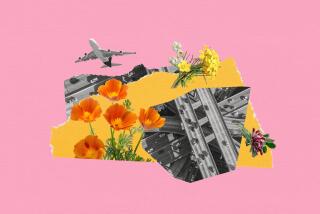In These Drying Times : Drought: A futurist suggests artificial plants may be the ecologically correct alternative to thirsty outdoor greenery.
- Share via
When Roger Vick’s idea for water conservation was unveiled a year ago, it seemed much too commercial, shallow and artificial. But that was before the California drought tightened its grip.
Now, with Santa Barbara residents painting dried-up lawns green because watering their grass is illegal, and the North Marin Water District paying homeowners to replace water-guzzling lawns with drought-tolerant succulents, Vick’s idea is starting to look perfectly logical.
And since today is Los Angeles’ official Water Conservation Day, the timing seems perfect for introducing Vick’s idea to Californians who want green lawns and flowering geraniums without tapping their water rations.
Vick’s solution to the water shortage: The artificial plant, or the “un-plant.”
A horticulturist, futurist and curator of Devonian Botanic Garden at the University of Alberta in Canada, Vick published his thoughts on artificial plants in the July-August 1989 edition of Futurist magazine.
Considering the growing popularity of indoor artificial plants, Vick speculated that the logical future would be to move them outdoors on a grand scale. He saw a future abloom with synthetic lawns and artificial shrubs. He even predicted fake flowering plants with “buds” programmed to open at seasonal intervals.
Why? Because in looking ahead, one of the things Vick saw was drought.
“In some regions,” he wrote, “water shortages will result in strict regulations to ensure that irrigation is used for essential purposes only . . ..”
Vick wrote the essay, he said recently by phone, “because I could see that there were areas of the world where water shortage was going to be a serious consideration. And rather than have live plants shrivel up and die, I thought people should look for alternatives.”
Although the technology cannot produce synthetic plant materials that are totally weatherproof (“un-trees” that were “planted” in the California desert in the 1970s melted in the sun), he thinks the situation will be market-driven. Once there is a demand, a superior product will be produced.
“There are several distinct advantages to realistic imitation plants. First, they don’t need soil. Nor do they need a planting medium with balanced nutrients. They don’t need weeding, pruning back or tying up,” he said.
Artificial plants, which require neither lethal pesticides nor biological pest control to stay alive, already are being used to beautify offices, hospitals, restaurants and other public places where health safety is a consideration.
“Un-plants” can even look real enough to water, Vick noted. The one-time stiff plastic flower “growing” in an imitation clay pot--instantly recognizable as fake--has given way to plants of silk-screen polyester foliage that fool even a gardener’s eye.
Which brings us to present-day California, where water engineers have just declared 1990 the most severe year of the current drought so far, and the fifth-driest year of the century.
The water crisis has unleashed a stream of official quarrels and counter-charges about who is wasting water, and--as hotter weather approaches--some severe talk about how to cut back.
Clearly, large lush lawns are expendable on the scale of human water needs. Santa Barbara may have become the first Southern California city to ban lawn watering as part of its “drought emergency” status, but it is not expected to be the only one. Even Los Angeles Mayor Tom Bradley, not known as an alarmist, says his gardener will cut watering by one-third.
In North Marin County, the realization that 90% of outside water use was for lawns resulted in several offbeat incentive programs at the Marin Water District:
* Customers are paid to tear out their existing water-guzzling grass lawns and replace them with xeriscapes of drought-tolerant plants;
* Developers and new homeowners are paid not to plant grass in their bare yards in the first place.
The idea is to get rid of thirsty, grassy lawns. But many people like lawns, and for them, Vick envisions an “un-lawn” mix that would look like Kentucky bluegrass and creeping red fescue.
“That’s a combination of coarse and fine grass,” he said, “and you could even stick a few dandelions and other weeds in it to give it a realistic appearance.”
Vick has no interest in capitalizing on the “un-plant” market. As a horticulturist who oversees thousands of plant varieties at the University of Alberta’s sprawling botanical gardens, he has been criticized for even writing the article in the first place.
“It does seem a little far out,” he said. “I’m not advocating the ‘un-plant’--my job is live plants. But let’s look at the situation, and what’s happening, and the possibility is right there. Forewarned is forearmed.”
California homeowners who are painting dying grass or spreading green gravel just to have something that looks like a real lawn might consider the artificial option, even though an “un-lawn” sounds ominous in an era where technology is eroding our vital connections with nature.
Vick isn’t shocked by the notion of Californians painting their lawns green. In fact, he considers it a compliment to nature: “People are trying to imitate it if they can’t get it naturally.”
Perhaps that’s because green is psychologically soothing.
“It is a relaxing color,” he said. “One of the popular phrases up here today is ‘stressed-out,’ and when people are surrounded by a harsh environment, they probably feel more stressful than when they are surrounded by trees and flowers and green grass”--even the green of “un-grass.”






